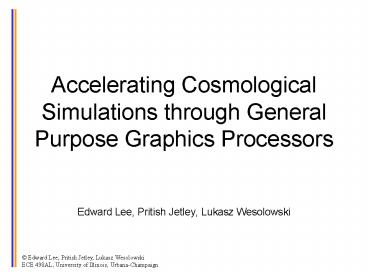Accelerating Cosmological Simulations through General Purpose Graphics Processors Edward Lee, Pritis - PowerPoint PPT Presentation
1 / 22
Title:
Accelerating Cosmological Simulations through General Purpose Graphics Processors Edward Lee, Pritis
Description:
The particles are in close proximity in a universe with periodic boundary condition ... therefore, no sharing between threads across blocks. Code Features, contd. ... – PowerPoint PPT presentation
Number of Views:19
Avg rating:3.0/5.0
Title: Accelerating Cosmological Simulations through General Purpose Graphics Processors Edward Lee, Pritis
1
Accelerating Cosmological Simulations through
General Purpose Graphics Processors Edward
Lee, Pritish Jetley, Lukasz Wesolowski
2
N-body Simulations
- Simulate gravity force interactions
- Model millions of particles
- Motivations
- Used to study galaxies and large structures
- See if results matches theory
3
N-body Implementations
- Pairwise computation between particles
- O(N2) so infeasible for large systems
- Barnes-Hut estimation
- Approximate far-away particles as one
- Hierarchical decomposition of space
- Generate tree structures with particles leaves
- Traverse tree to compute force
- Open nodes only if it's close
4
Optimization Potential
- Gravity computation
- Group particles into buckets
- Process buckets in parallel for computations
- Force comp., subtree walk, space decomposition
- Ewald summation
- Allow particles at far ends to interact with each
other with replicated universes - Compute acceleration and potential of particles
then consider far-away effects
5
Periodic Boundary Condition
- Cube-shaped universe model
- A and B on opposite faces of the cube
- The particles are in close proximity in a
universe with periodic boundary condition
6
Ewald Summation
- 3D array of replicas of the universe
- Local summation in space domain
- Global summation in Fourier domain
7
Implementation
- Two kernels
- Local summation
- Fourier domain summation
- One thread per particle
8
Local Summation Kernel
- Triple-nested for loop
- 343 iterations for 5 million particle set
- Branch inside
- Special functions erfc, expf, sqrt
- Some integer calculation overhead
9
Fourier Summation Kernel
- For loop
- 80 iterations for 5 million particle set
- Special functions cos, sin
- Overall speedup for both kernels 9.6x
10
Gravity Computation
- Control flow
- Transfer particle and tree data to device
- Compute interaction lists for buckets on host
- Transfer lists to device
- Commence force computation on device
- Synchronize, transfer results from device
- Update host data structures
- Can't calculate all forces simultaneously
- memory constraints
- list computation times prohibitive
11
CUDA Implementation
- Split computation into chunks'
- Sets of contiguously numbered buckets
- Buckets in chunks spatially proximal
- Advantages
- Smaller memory footprint
- Can overlap list construction of one chunk with
force computation of previous - Force computation becomes essentially free!
12
CUDA Implementation, contd.
- Further reduction
- All buckets refer to nodes/particles from among
the same universal set lots of repetitions - Use indirection in lists
- Example
- No chunks, no indirection node lists alone 44 GB
- Chunked computation (100 chunks per iteration)
427 MB - With indirection 65 MB (62 MB node data)?
13
Code Features
- Clean interface between CUDA and Charm (C)
code - Kernel force computation organization
- Given a set of particles S and an interaction
list L, iteration space is S L - Different ways to split points in iteration space
between threads - Assign a single block to a bucket
- therefore, no sharing between threads across
blocks
14
Code Features, contd.
- Organizing kernel computations
15
Code Features, contd.
- Group-based scheme has better global memory
access access - But requires slightly greater amount of shared
memory per block - Used in current implementation
16
Performance Insights
- Decreasing chunk size (computation grain)
improves execution time - Exact cause unknown
- Speculation
- list construction memory intensive
- random memory access pattern, increased TLB and
cache misses - GPU held up by CPU
- Knowing correct chunk size is critical
17
Test Framework
- Compares results from with expected values
- small 30,000 particle data set
- Good accuracy results
- GPU version
- RMS 0.015855065808977459
- Maximum 0.51600037721903569
- CPU version (double precision)?
- RMS 0.015855063670699353
- Maximum 0.51600645407026324
18
Performance
- Highly clustered, 5M particle data set
- Application execution times
19
Performance, contd.
- Time break up
20
Performance, contd.
- Data transfer traffic
21
Performance, contd.
- Speedups
- nodeGravityComputation 25.094
- particleGravityComputation 60.049
- Application 9.02
22
Future Work
- Automatic, measurement based interpolation of
performance parameters - Exploit other parallel parts of algorithm
- Multiple CPU's and GPU's
- Quantitative study of trade-offs, how exactly
various factors affect performance - Approximate model of computation?































